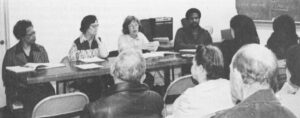Bachman’s Warbler
 (RED HOOK, N.Y.) –It might have become another snail darter case, the celebrated imbroglio between an obscure fish and a Tennessee dam. The endangered creature in this instance was an elusive South Carolina swamp bird whose buzzlike song is heard more often than its flitting yellow-and-green shape is seen. The threat to Bachman’s warbler was not a dam but a proposed logging operation that could have decimated its nesting ground in Francis Marion National Forest. The issue, however, was familiar: should the possible extinction of a rare form of life extinguish an economically important undertaking.
(RED HOOK, N.Y.) –It might have become another snail darter case, the celebrated imbroglio between an obscure fish and a Tennessee dam. The endangered creature in this instance was an elusive South Carolina swamp bird whose buzzlike song is heard more often than its flitting yellow-and-green shape is seen. The threat to Bachman’s warbler was not a dam but a proposed logging operation that could have decimated its nesting ground in Francis Marion National Forest. The issue, however, was familiar: should the possible extinction of a rare form of life extinguish an economically important undertaking.
In the snail darter controversy, the opponents managed to turn a dispute over a fish into legal bouillabaisse, the final serving dished up before the United States Supreme Court. The warbler dispute, in contrast, was settled simply and amicably, because the antagonists, the National Wildlife Federation and the U.S. Forest Service, hit upon an ingenious way around their impasse.
They convened a triumvirate of respected biologists. Each side chose one member of the panel, and those two selected the third. After six months of deliberation, including field trips and a hearing, the panel issued a recommendation: no logging should be permitted in the forest’s bottomland hardwoods, the warbler’s favorite haunts, but judicious tree cutting should be allowed in the upland pines. Both sides accepted the recommendation, which has been adhered to for the last four years. “When it was all over,” recalls Robert Golten, the attorney for the wildlife federation, “the parties were still speaking to each other.”
A seasoned environmental litigator, Golten drew a moral from his unexpectedly agreeable experience with a non-litigious approach: “Now and then you need a judge and jury to resolve environmental disputes-but not all the time.” His conviction is shared increasingly on both sides of the environmental battle lines, reflecting disenchantment with the court-room as an all-purpose forum for making decisions about the use of natural resources, protection of flora and fauna, preservation of clean air and water, disposal of toxic wastes and a host of related issues. The antagonists have begun to turn toward “nonadversarial” methods and to the services of an expanding corps of environmental mediators.
For a young vocation, it is already deeply awash in jargon. Mediators are wont to describe their function in such emollient terms as “conflict management,” “collaborative problem solving,” or “cooperative assessment.” The methods are as varied as the terminology. The intermediaries may chair meetings between the disputing parties (often labeled “stakeholders”, carry messages between them, engage in fact-finding, or make recommendations-as did the panel that resolved the warbler’s fate. The assumption underlying each technique is that intervention by an impartial “third party” can help the opponents grope their way to a mutually acceptable outcome. “A mediator is simply a doctor of negotiation, explains David O’Connor, the chief of the New England Environmental Mediation Project in Boston.

Attending to the health of negotiations has produced some notable successes for O’Connor and his colleagues. He secured an agreement on water levels in a lakefront community that allowed a small hydroelectric dam in Swanville, Maine, to return to service, and he helped fashion an accord under which a major power plant in Brayton Point, Massachusetts, converted from imported oil to domestic coal. A dispute over a new site for the Eau Claire, Wisconsin, city landfill was resolved through the efforts of mediator Howard Bellman of the Wisconsin Center for Public Policy. An abandoned rail spur in Columbia, Missouri, is being converted into a recreation trail because mediators commissioned by the U.S. Geological Survey forged an agreement among landowners and local officials.
Even more ambitious efforts are underway. Mediators are trying to secure agreement on a master plan for the California desert, and others are trying to resolve a bitter controversy over the reclamation of a mile-long scar that will be left in the Gunnison National Forest in Colorado by a uranium mining operation.
There is broad scope for peacemaking, because the number of environmental contests has grown exponentially during the last decade. A recent study by the Energy Environment Conflict Project at New York University catalogued 1,800 disputes. Many of these end up in court. A series of enactments, including the National Environmental Policy Act of 1969, the Clean Water Act of 1969, the Clean Air Act of 1970 and the Endangered Species Act of 1973, as well as volumes of federal and state administrative regulations, have given lawyers for the environmental cause significant leverage.
But, as Ethan Smith, a planner at the Geological Survey, argues, “litigation is just not efficient. There are incredible delays, high costs and even when someone is declared the winner he doesn’t feel like a winner.” A ruling based on a narrow technical point may leave the environmental issue unresolved, amounting to nothing more than an expensive Pyrrhic victory. Attorney Golten remembers litigating for two years over a bridge in Lake Worth, Florida. “In the end, he says “theoretically, it was a tie. In reality, we lost. All we got was a blizzard of paper.” In another instance, Golten’s legal efforts to protect a sandhill crane from highway builders in Mississippi cost taxpayers $10 million in added land acquisition costs for an interchange. A mediated solution, he believes, would have called for a much cheaper expedient: moving the interchange.
Environmentalists also smart at the memory of the political backlash of the snail darter case. Although they were upheld by the Supreme Court, Congress passed a rider allowing the dam to proceed and weakening the legal protection of endangered species.
The mediation movement, moreover, is spurred by a belief, among the mediators at least, that nothing pollutes the atmosphere more than unrestrained invective of the type aroused by environmental confiVIIL4tions. They worry that adversarial showdowns are leading to a polarization between the environmental and industrial communities, and that the recent economic downturn as well as the drive for “energy independence” could intensify the hostility. “You look out in the world and see all these conflicts and no way of solving them in a manner satisfactory to all sides,” sighs Gail Bingham of Resolve, a California mediation organization. “You’ve got all these win-lose situations.”
The premise of mediation is that winlose situations merely seem that way on the surface. The task of the intermediary, patterned after that of the labor mediator, is to plumb beneath the surface until he strikes common ground. But unlike standard, two-sided labor talks, environmental bargaining is often multi-sided, and the first challenge to the mediator’s skill is to decide who belongs around the table. In the Eau Claire landfill dispute, mediator Bellman gathered together representatives of several local governments and state agencies as well as bargaining teams from a number of citizen groups. “If you exclude any important group, Bellman cautions, I ‘you won’t get a resolution.”
The next step was to determine the real dispute. The parties had been quarreling about the adequacy of the environmental impact statement for the proposed landfill site, a replacement for the now-full city dump. Water pollution was the ostensible issue. “We established some facts,” Bellman recalls, “eliminating disputes over factual matters. Then we got down to the real issues, which turned out to be: How will the site be run? What hours will it be open? Who can use it? What kind of trucks will arrive? What will happen when it’s full? If it becomes a park, who will own the park?” It took three meetings to hammer out an agreement, whose core was a guarantee that the site would be engineered and operated in a manner acceptable to the neighbors.
Bellman structured the talks so that they didn’t lapse into futile haggling. “People don’t know how to negotiate,” he says. “The mediator can, for one thing, provide a protected atmosphere in which a party can make an offer of settlement: ‘We’ll do this, if you do that.’ They don’t have their constituents looking over their shoulder.,’ The wise mediator also refrains from offering technical advice. “We stick to the process, ” he says. “The parties are already experts on the problem.”
They may also be part of the problem, explains Susan Carriduff, a mediator on the staff of the New England project: “People know what they object to but not what they want to come out of the negotiations. We find a remarkable inability to specify goals. “
A checklist published recently by the Office of Environmental Mediation at the University of Washington in Seattle urged prospective bargainers to take into account these points, among others, before entering into mediation:
“Are the negotiators for each party able to speak for their constituency?”
“Has a realistic deadline been set for the negotiations? “
“Do you trust the mediator to carry messages when appropriate and to honor confidential remarks?”
The questions come from the office’s director, Gerald W. Cormick, widely regarded as a pioneer in the field for his work in securing an agreement for a flood control system in Washington’s Snoqualmie Snohomish River Basin.
Cormick urges mediators to inject realism into the talks, to ensure that the parties have considered whether the agreement reached is feasible technically, legally, financially and politically. “There are always likely to be interests not represented by the parties,” Cormick says. “In a waste management dispute, the easy solution is to propose the site be located in some one else’s backyard. That is not a solution. It’s just a way of sloughing the problem off.”
The public interest is especially prominent when the parties are government agencies with overlapping jurisdictions. Cormick’s office mediated a dispute over the extension of Interstate 90 through Seattle; it resulted in an intergovernmental compact among the mayors of the cities of Seattle, Bellevue and Mercer Island; the King County executive; the chairman of the State Highway Commission; and the chairman of Metro, the county transit agency. (Improvements in other corridors to relieve 1-90’s traffic and pollution were among the trade-offs in the document.) Public curiosity ran so high that some of the formal sessions during the nine months of negotiations were televised-although the real dealing occurred off-camera during the coffee breaks.
Like the 1-90 negotiations, the Brayton Point power plant dispute in Massachusetts resulted in a complex package deal, involving Federal as well as state agencies. The U.S. Department of Energy wanted the plant to convert to coal to reduce the nation’s dependency on imported oil, but Federal and state environmental regulators objected to the likely increases in air pollution from sulfur and particle emissions. The solution: the sulfur emissions standards were relaxed slightly in return for a pledge by the New England Power Company to install electrostatic precipitators to control particles, locally the more serious threat to air quality. In addition, the regulators guaranteed that the standards would not be tightened for 10 years. That allowed the company to buy a long-term supply of coal at reasonable prices, partially offsetting its investment in the control equipment.
The Brayton Point agreement was expressed in terms like “Ibs per Mbtu;” many mediations involve similarly technical engineering issues or tortuously complex questions of ecological balance. In the Colorado mining dispute, the negotiators need to establish how the water table has been affected, how wildlife migration patterns have been changed and whether revegetation of the and soil is possible. The stakes are high. The estimated cost of backfilling the mining pit is $38 million.
Because of the technical matters involved, some of those being drawn into the mediation field are university-trained experts in scientific subjects ranging from forestry to molecular biophysics. Computer scientists may be next. The use of computers has been suggested to analyze technical questions, provide a common data bank and expand the range of alternatives beyond those that the disputants may have considered without the aid of artificial intelligence.
Timing is a crucial aspect of mediation and one on which there are various schools of thought. Orville Tice, a mediator on Cormick’s staff, believes that a dispute must ripen. “In many instances,” he contends, “it’s not until parties have tested one another and are uncertain of their own ability to prevail that they are ready to negotiate seriously.” Assessing a dispute over a power line in Alaska, the office concluded that since “one party was essentially I winning’… there was no reason to expect them to negotiate.”
Another mediation group, the Romcoe Center for Environmental Problem Solving in Boulder, Colorado, has opted for a preventive strategy, which it dubs “conflict anticipation.” Associate Director Susan Carpenter maintains that “it’s better to approach a dispute early, before the sides have polarized. If you wait until late, you spend a lot or time just getting them to stop shouting at each other. Besides, many disputes are based on lack of information. If that information were available early, there wouldn’t be any conflict.”
Last February, Romcoe invited 30 persons representing corporations, environmental groups and regulatory agencies to a three-day session on air quality. “They arrived hostile,” Ms. Carpenter says. “You could see their advocacy mentality. But we were able to cool them off. We took them to the best Mexican restaurant in town on a double-decker bus and had a lot of fun. They began talking to each other as people, and they were forced to think beyond their knee jerk responses, to look at the other sides’ needs.” The upshot was several jointly written statements of general principles.
Another Rocky Mountain group, the Keystone, Colorado, Center for Continuing Education reports similar successes in multi-lateral discussions of nuclear waste disposal. The state of Colorado itself recently instituted a “joint review process” that attempts to bring state and federal regulators together with citizen groups and industry representatives at an early stage in the licensing procedure to consider environmental objections to mining and manufacturing projects.
There have also been regional and industry-wide efforts at conciliation. The New England River Basins Commission sponsors multi-sided talks on guidelines for power plant siting in the region. A National Coal Industry Project has been working out environmental ground rules for that critical energy resource. “It’s the only way some of the hard questions are going to be resolved,” says Alan McGowan, president of the Scientists’ Institute for Public Information, a technical clearinghouse. “A lot of people realize it’s better than going to the barricades.”
Still, mediation has yet to become a routine alternative. Businesses are often reluctant to enter into it because they doubt that the opposing coalition is sufficiently cohesive to strike a lasting bargain. Environmentalists sometimes harbor suspicions about mediation organizations because, although most rely on grants from foundations like Ford and Rockefeller, some receive corporate contributions. They are also wary of what they call “conflict suppression,” con.
The Brayton Point Power Plant, Massachusetts tending that conflict has the salutary effect of focusing attention on neglected issues and mobilizing unorganized defenders of the environment. Moreover, to some environmental strategists the very notion of compromise smacks of a sell-out-even though mediators are fond of quoting community organizer Saul Alinsky’s dictum: “If you start with nothing, demand 100 percent, then compromise for 30 percent, you’re 30 percent ahead.”
Mediators concede that disputes involving value differences are virtually impossible to resolve. “If one side is philosophically or morally opposed to nuclear power, there is no room for mediation,” says David O’Connor. “You can’t get an agreement by making the nuclear plant smaller or painting it green.” Howard Bellman -agrees that “if someone says I’ll only accept the other party’s going out of business there’s no place for a mediator.” Indeed, in the Colorado mine dispute one group dropped out of the negotiations because it was ideologically opposed to the mining of uranium for nuclear fuel and weapons material-regardless of whether the land could be reclaimed.
Based on his study of past environmental conflicts, Professor Thomas Gladwin of the New York University Graduate School of Business, argues that the “conditions needed to make mediation work are quite restrictive.” Retorts O’Connor: “That’s a self-fulfilling prophecy. It looks only at what has occurred. Mediation has not been widely promoted or advertised as an option. If the groundwork gets done, much of that objection will melt away.”
O’Connor and many other mediators believe that they now need not causes c6lebres but a steady caseload of garden variety disputes to establish mediation as an everyday alternative. As Bellman says of the Eau Claire dispute: “It’s not glorious. It doesn’t involve thousands of people. It’s mundane, and that’s the way it ought to be. Landfill disputes all over the country have the same issues. If one could resolve them, one would make an enormous contribution.”
Similarly, the Missouri “rail to trail” case could have important consequences. About 20,000 miles of right-of-way are expected to be abandoned in the next few years by railroads going out of the shortline business. The techniques applied in Missouri to build consensus among homeowners, developers, farmers and outdoor enthusiasts could well determine the way in which that land is put to use.
Even the case of the tiny Swariville dam is potentially significant. About a thousand dams scattered throughout Maine could be returned to generating service if similar environmental settlements could be reached.
Many such small triumphs will be necessary, the practitioners agree, before mediation is fully accepted. Says O’Connor, “Mediation suffers from having been jumped on as a panacea. But when people are in a fight, the person waving the flag of peace may not be popular.”
©1980 Richard V. Denenberg
Richard V. Denenberg is investigating “Alternatives to Traditional Courts.”





